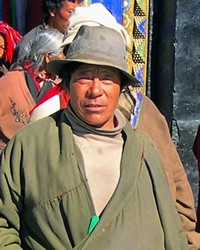Tibetan Gtsang in China

Photo Source:
Copyrighted © 2026
Claudio Zaccherini - Shutterstock All rights reserved. Used with permission |
Send Joshua Project a map of this people group.
|
| People Name: | Tibetan Gtsang |
| Country: | China |
| 10/40 Window: | Yes |
| Population: | 753,000 |
| World Population: | 753,000 |
| Primary Language: | Tibetan, Central |
| Primary Religion: | Buddhism |
| Christian Adherents: | 0.02 % |
| Evangelicals: | 0.01 % |
| Scripture: | Complete Bible |
| Ministry Resources: | Yes |
| Jesus Film: | Yes |
| Audio Recordings: | Yes |
| People Cluster: | South Asia Buddhist |
| Affinity Bloc: | South Asian Peoples |
| Progress Level: |
|
Introduction / History
The Gtsang Tibetans are part of the Tibetan nationality, but they speak a language only partly intelligible with other Tibetan varieties.
Xigaze, the capital of Tibet from 1618 to 1642, is the traditional seat of the Panchen Lama, Tibet's second most powerful ruler after the Dalai Lama. In 1954 the city was nearly destroyed by floods. After putting down a revolt in 1959, the Chinese imprisoned 400 monks in the Tashilhunpo Monastery.
What Are Their Lives Like?
The Xigaze New Year Festival is held in the first week of the 12th lunar month. Thousands of visitors have flocked to Gyantse since 1408 for the annual Horse Racing and Archery Show.
What Are Their Beliefs?
The Gtsang region is home to several Buddhist sects, including the Nyingmapa (Ancient), Kagyupa (Oral Transmission), and Sakya (Gray Earth) schools. After the death of the Panchen Lama in 1989, the Chinese filled his position with their own choice of successor. In May 1995 the exiled Dalai Lama announced a new Panchen Lama who was immediately rejected by the Chinese. Monks at the Tashilhunpo Monastery, and a number of lay Tibetans, rioted in protest. Eighty monks were interrogated by the police, and the city of Xigatse was sealed off for several days. Tensions have remained high since then.
Jesuit missionary Antonio de Andrade arrived in Tibet from India in 1624 by disguising himself as a Hindu pilgrim. "Andrade outwitted hostile local officials, made his way north to the Himalayas, endured altitude sickness and snow blindness, fought his way over a 17,900-foot pass into Tibet, and finally reached Tsaparang. ... There he impressed the king and queen with his piety, and they gave him permission to return, establish a mission, and preach the Gospel." A revolution in Tsaparang in 1635 abruptly ended the Jesuit mission. Today there are just a handful of Gtsang Tibetan Christians.
What Are Their Needs?
Like people everywhere, the Gtsang Tibetan people need to allow the loving Savior to direct their lives. They need his forgiveness for sin.
Prayer Points
Pray for the Lord to intervene in their families, calling people to his side.
Pray for loving workers.
Pray for their hearts to be drawn to the Lord of lords.
Pray for a church planting movement to thrive in their communities.